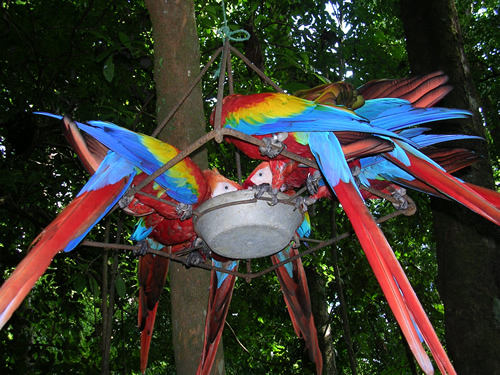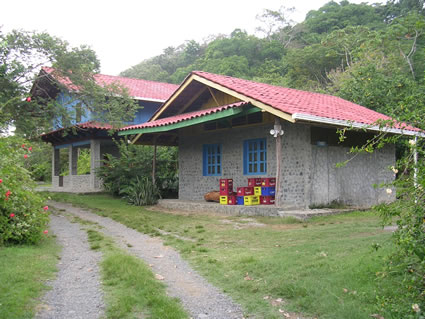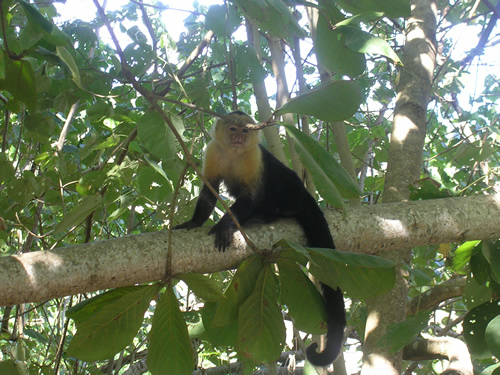Ecotourism and Volunteer Conservation in Costa Rica
Monitoring Wild-Release Macaws: Hatched to Fly Free
Articles and photos By Theodore G. Manno

|
|
Feeding Macaws.
|
Upon arriving at the San José airport, a 3-dollar ride quickly took my aspiring career as a wildlife biologist to La Casa de Margarita in the Giralda neighborhood of Alajuela. I enjoyed Central American hospitality there and lived with other travelers while learning the ropes of the Amigos de las Aves captive breeding and wild release program for endangered scarlet macaws at the breeding center just down the street, and I also dined on the decadent chicken burritos and cinnamon-fried plantains included with the room and laundry services for $12 a day. Meetings with colleagues and careful study of biological records prepared me to learn about each macaw at the release site on the Panama border.
Starting with a local bus right in front of Margarita’s, I spent an entire day taking three buses, first to San José, then Golfito, and finally down a dirt road to Punta Banco (not to mention a raft across crocodile-infested waters). This exhausting journey covered an area no larger than Maryland, and upon arrival, a local helped me through the darkness to get to the jungle area on the Pacific Coast, where I would meet my new “friends.”
Tiskita Jungle Lodge and Conservation Volunteering
Tiskita Jungle Lodge and Conservation Volunteering is a privately owned, multiple-use property in the southwest corner of Costa Rica. In addition to plantations of fruit trees and cocoa, there is a wild macaw conservation program, a sea turtle conservation station, a smoothie shop, and even a small library. Managed by Peter Aspinall, who built a home on the property over 30 years ago while reforesting large sections of cleared land, the jungle habitat borders aboriginal lands and overlooks the stunning Pacific Ocean and an all-but-deserted beach with palm trees. A series of trails serve not only hikers but also lead to a bird feeding station where volunteers can observe scarlet macaws born at their breeding center in Alajuela. When I arrived, the birds were in courtship following their recent introduction to the wild, and they came to the feeding station once a day on their flying route.

|
|
Field Site at Tiskita Jungle Lodge.
|
Volunteers are accepted year-round and on short notice directly through Tiskita. Reintroduction program volunteers are typically first sent to the breeding center and usually stay in Costa Rica for at least six weeks. Dry-season tenures (i.e., December-March) are frequently more enjoyable due to the drier weather. Independent studies for university students in biology or other interested parties may be arranged through Mr. Dale Forbes, the biologist for the program. Still, academic experience is optional for volunteers. Living conditions in Tiskita consist of a hut in the jungle with a bathroom and bed. Food can be bought 2 miles down the road for $2/day from a home-based business in Punta Banco. Electricity recently arrived in the area and is included. Phone service and a doctor are available in Pavonnes (1.5 hr walk, 20 min. moped ride); internet service and shopping are accessible in Paso Canoas (50 km away; takes 4 hrs, 3 buses, and a cab), which straddles the Panamanian border.
Unlike at the breeding center, there were only a few volunteers at Tiskita Jungle Lodge, so there was a lot of private time. Most volunteers were from Europe, particularly Britain, but there were also a few North Americans. A typical day in Tiskita consisted of a 5 a.m. wakeup to observe the morning flights of the macaws, followed by a mid-day swim, 2:30 p.m. observations at a feeding station, flight observations at dusk, and watching the sun go down over immaculate beach at Punta Banco. I enjoyed the Costa Rican way of life, and the locals were friendly, even allowing us volunteers to participate in their daily soccer game and helping us learn Spanish.
Given my prior experience, watching animals in the field was routine, but the task also included strenuous hiking. Note-taking and observation in the field were tedious at times. Still, I was more than rewarded by bonding with individual birds at the feeding station, which provided me with memories that would last a lifetime.
Ecotourism and Conservation in Costa Rica
Despite its small size, Costa Rica holds 5% of the world’s biodiversity. It is, therefore, a vital area for conservation and has a green history involving pioneers in ecology and ecotourism, such as Alexander Skutch, Michael Kaye, and Archie Carr. The Tiskita Jungle Lodge collaborates with Amigos de las Aves to protect indigenous wildlife through rescue, scientific research, and public education. Donations and volunteer work are important sources of funding for this coalition.
Aspinall, the owner of Tiskita Jungle Lodge, has succeeded in conserving this thriving ecosystem in Southern Costa Rica by creating a multiple-use habitat that combines protected areas with commercial crops. The diverse local wildlife includes many tropical birds, such as toucans, pelicans, hummingbirds, and trogons, as well as mammals, such as agoutis, hump-backed whales, peccaries, sloths, variegated squirrels, anteaters, and several species of monkeys. Black iguanas were common, and I even encountered one in the shack after returning from the field. Besides plantains, cocoa, star fruit, mangoes, and papaya, many fruits unknown to the New World are also grown at Tiskita for economic purposes from seeds collected during Aspinall’s trips to Asia. Plants used for condiments and beverages, such as vanilla, cardamom, bay rum, and cupuazu, are abundant. Be aware that mosquitoes and chiggers are also numerous. Wear long pants at all times and use an environmentally friendly bug spray.

|
|
A Monkey hanging out in Costa Rica
|
Travel
Tiskita is a half-day bus ride away from the Corcovado National Park on the Osa Peninsula. You can also take the bus down the dirt road, transfer, return to the capital, San José, and stay at Margarita’s. San José is the best gateway for further exploration of the Nicoya Peninsula (via Liberia or bus and ferry via Puntarenas) or the famous Tortuguero National Park (probably via Limón). After backpacking the country's length, the Nicoya Peninsula particularly appealed to me because of the possibility of watching female sea turtles coming to the beach at Playa Grande (by bus via Liberia and cab via Tamarindo) to lay eggs. But when I reached Playa Grande, the biologist at the site told me there were only 48 turtles that had come ashore that year.
Having waited patiently at the beach throughout the night for a few days, I left Costa Rica, knowing the importance of volunteer work in conservation.
Theodore G. Manno is a PhD candidate in biology at Auburn University. Besides field trips to the tropics, he has also lived with alpine-dwelling squirrels in Canada and Utah. A contributor of scientific and popular articles to outlets such as American Naturalist, Animal Behaviour, Journal of Mammalogy, and Nature Alberta.
|
